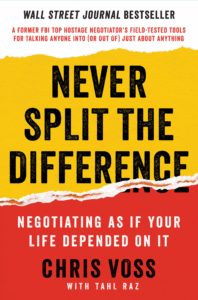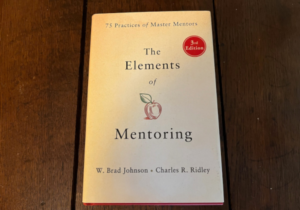Never Split the Difference: Negotiating As If Your Life Depended on It
Getting to Yes may still be the bible of negotiation books, but Chris Voss’s Never Split the Difference offers an intriguing alternative perspective. Instead of preaching objectivity and separating the people from the situation, Voss, a former FBI crisis negotiator, teaches how to wade into the messy emotions of a negotiation and make tactical use of them to get what you want.
 Voss introduces each chapter with a case study from his FBI career before dissecting the situation and tools he used to handle it, which makes this book more of a page-turner than you might expect from a business book. Key to Voss’s approach is empathy for the other party in the negotiation. This doesn’t (necessarily) mean being nice to them, but rather understanding why the other person’s actions make sense to them. Once you have developed empathy with the other party, several tools become available to you.
Voss introduces each chapter with a case study from his FBI career before dissecting the situation and tools he used to handle it, which makes this book more of a page-turner than you might expect from a business book. Key to Voss’s approach is empathy for the other party in the negotiation. This doesn’t (necessarily) mean being nice to them, but rather understanding why the other person’s actions make sense to them. Once you have developed empathy with the other party, several tools become available to you.
Voss posits that behind each objective argument lies an emotional driver, and speaking to that driver results in a better outcome for you. Through labeling emotions and “accusation audits,” strong emotions can be identified and defused. (Tricks such as the “Late Night FM DJ Voice” help here too.) Examples of this in the book include overcoming a potential donor’s reluctance by labeling her fears (the charity won’t use the donation in the way she wants); representatives from one company acknowledging their actions look bad to a partner company, thus breaking through animosity to work on solutions; and Voss himself acknowledging two fugitives’ fear of the FBI team outside their door until they gave themselves up, convinced they would not be shot on sight.
Along with labeling emotions, one of the most valuable strategies Voss recommends is using questions that begin with “what” or “how” to elicit more information and work towards agreement. For example, instead of “does this work for you,” ask, “What about this works/doesn’t work for you?” With these kinds of questions, you implicitly ask for help, which triggers goodwill, and gently engineers the situation so that the other party uses mental energy and resources to overcome your challenges, thus guiding him or her into helping you design a solution.
These questions also engage the other party and allow them to feel in control. Voss uses the example of kidnappers asking for a large sum of ransom money; he (calmly!) replies, “How am I supposed to do that?” thus engaging the kidnappers in building resolution. This tool might be useful if a chair asks you to take on so much clinic time that it interferes with your K’s 75% protected time. Try asking, “How am I supposed to balance X days of clinic with the time the NIH requires I spend on research?”
Dozens of strategies like this wait inside the pages of this book, well-explained and exemplified with situations where they have worked in the business, personal, and law enforcement realms. How can you afford to pass it up?
More Resources
Asking for What You Need: Intentional Negotiation
Like It or Not, You’re a Negotiator: Getting to Yes
You Can’t Always Get What You Want, But It’s Worth a Try






0 Comments